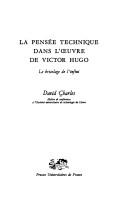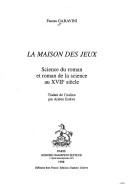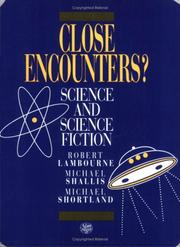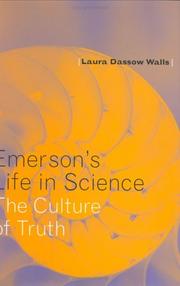| Listing 1 - 10 of 37 | << page >> |
Sort by
|
Book
ISBN: 9782807324718 2807324711 Year: 2019 Publisher: Louvain-la-Neuve: De Boeck,
Abstract | Keywords | Export | Availability | Bookmark
 Loading...
Loading...Choose an application
- Reference Manager
- EndNote
- RefWorks (Direct export to RefWorks)
La quatrième de couverture indique : "Ce livre décortique le monde du petit sorcier sous un prisme nouveau : celui des sciences. Cette rencontre entre la magie et les sciences lie les deux univers de façon ludique, originale et toujours empreinte de l'esprit vif et malicieux de sa créatrice J. K. Rowling. A travers quatre grandes thématiques, ce livre passe en revue les singularités du monde ensorcelant de Harry Potter : Philosophie magique ; Ruses et gadgets techniques ; Botanique, zoologie et potions ; Pot-pourri magique. Vous découvrirez que les frontières entre notre monde et celui de la magie sont parfois plus ténues qu'on ne peut le penser. Mark Brake et Jon Chase nous démontrent que nous pouvons aujourd'hui accomplir certains exploits magiques. Qui n'a jamais rêvé de créer l'horloge de la famille Weasley ou sa propre carte du Maraudeur ? Mais comment ? Grâce aux sciences, tout simplement ! Avec elles, nous avons désormais la possibilité de devenir tous un peu sorcier !"
Book
Abstract | Keywords | Export | Availability | Bookmark
 Loading...
Loading...Choose an application
- Reference Manager
- EndNote
- RefWorks (Direct export to RefWorks)
Book
ISBN: 2746505487 9782746505483 Year: 2014 Publisher: Paris: Le pommier,
Abstract | Keywords | Export | Availability | Bookmark
 Loading...
Loading...Choose an application
- Reference Manager
- EndNote
- RefWorks (Direct export to RefWorks)
Roland Lehoucq se propose d'analyser les grands thèmes de la science-fiction grâce aux outils de la physique. Il tentera ainsi de répondre à toutes les questions que posent ces explorations extraordinaires : peut-on, pourra-t-on, aller au centre de la Terre ? voyager dans le temps ? se déplacer aussi vite que la vitesse de la lumière ? visiter les étoiles voisines ? habiter une autre Terre ? Décollage immédiat et lecture à la vitesse de la lumière !

ISBN: 3826014081 Year: 1998 Publisher: Würzburg : Königshausen und Neumann,
Abstract | Keywords | Export | Availability | Bookmark
 Loading...
Loading...Choose an application
- Reference Manager
- EndNote
- RefWorks (Direct export to RefWorks)
LITTERATURE ALLEMANDE --- EVOLUTION DANS LA LITTERATURE --- LITTERATURE ET SCIENCES --- SCIENCES DANS LA LITTERATURE --- 19E SIECLE --- HISTOIRE ET CRITIQUE --- 20E SIECLE
Book
ISBN: 0813065267 0813057396 081306628X Year: 2020 Publisher: Gainesville, Florida : University Press of Florida,
Abstract | Keywords | Export | Availability | Bookmark
 Loading...
Loading...Choose an application
- Reference Manager
- EndNote
- RefWorks (Direct export to RefWorks)
"Joyce and Geometry" reveals the full extent to which the modernist writer James Joyce was influenced by the radical theories of non-Euclidean geometry. Tracing Joyce's obsession with measuring and mapping space throughout his works, Ciaran McMorran delves into a major theme in Joyce's work that has not been thoroughly explored until now.
Book
ISBN: 2862724262 9782862724263 Year: 2006 Volume: 30. Publisher: Saint-Etienne: Publications de l'Université de Saint-Étienne,
Abstract | Keywords | Export | Availability | Bookmark
 Loading...
Loading...Choose an application
- Reference Manager
- EndNote
- RefWorks (Direct export to RefWorks)
Science in literature. --- Sciences dans la littérature --- Poésie ancienne --- Sciences dans la littérature --- Poésie ancienne --- Classical poetry --- History and criticism. --- Histoire et critique

ISBN: 2130488447 Year: 1997 Volume: *56 Publisher: Paris : PUF,
Abstract | Keywords | Export | Availability | Bookmark
 Loading...
Loading...Choose an application
- Reference Manager
- EndNote
- RefWorks (Direct export to RefWorks)
Hugo, Victor --- Science in literature --- Sciences dans la littérature --- Technologie dans la littérature --- Technologie in de literatuur --- Technology in literature --- Wetenschappen in de literatuur --- Literature and technology --- Technology in literature. --- History --- Knowledge --- Science --- Technology

ISBN: 2852037939 9782852037939 Year: 1998 Volume: 18 Publisher: Paris : Champion,
Abstract | Keywords | Export | Availability | Bookmark
 Loading...
Loading...Choose an application
- Reference Manager
- EndNote
- RefWorks (Direct export to RefWorks)
Fiction --- French literature --- anno 1600-1699 --- Science in literature --- Sciences dans la littérature --- Wetenschappen in de literatuur --- French fiction --- Themes, motives. --- Sorel, Charles, --- Criticism and interpretation --- 17th century --- History and criticism --- Sorel, Charles

ISBN: 0852741413 Year: 1990 Publisher: Bristol Hilger
Abstract | Keywords | Export | Availability | Bookmark
 Loading...
Loading...Choose an application
- Reference Manager
- EndNote
- RefWorks (Direct export to RefWorks)
Comparative literature --- Thematology --- Science fiction --- Science in literature. --- Literature and science. --- Science-fiction --- Sciences dans la littérature --- Littérature et sciences --- History and criticism. --- Histoire et critique --- Sciences dans la littérature --- Littérature et sciences

ISBN: 0801440440 1501717391 Year: 2018 Publisher: Ithaca, NY : Cornell University Press,
Abstract | Keywords | Export | Availability | Bookmark
 Loading...
Loading...Choose an application
- Reference Manager
- EndNote
- RefWorks (Direct export to RefWorks)
Ralph Waldo Emerson has traditionally been cast as a dreamer and a mystic, concerned with the ideals of transcendentalism rather than the realities of contemporary science and technology. In Laura Dassow Walls's view Emerson was a leader of the secular avant-garde in his day. He helped to establish science as the popular norm of truth in America and to modernize American popular thought. In addition, he became a hero to a post-Darwinian generation of Victorian Dissenters, exemplifying the strong connection between transcendentalism and later nineteenth-century science.In his early years as a minister, Emerson read widely in natural philosophy (or physics), chemistry, geology, botany, and comparative anatomy. When he left the church, it was to seek the truths written in the book of nature rather than in books of scripture. While visiting the Paris Museum of Natural History during his first European tour, Emerson experienced a revelation so intense that he declared, "I will be a naturalist." Once he was back in the United States, his first step in realizing this ambition was to deliver a series of lectures on natural science. These lectures formed the basis for his first publication, Nature (1836), and his writings ever after reflected his intense and continuing interest in science.Walls finds that Emerson matured just as the concept of "the two cultures" emerged, when the disciplines of literature and science were divorcing each other even as he called repeatedly for their marriage. Consequently, Walls writes, half of Emerson's thought has been invisible to us: science was central to Emerson, to his language, to the basic organization of his career. In Emerson's Life in Science, she makes the case that no study of literary history can be complete without embracing science as part of literature. Conversely, she maintains, no history of science is complete unless we consider the role played by writers of literature who helped to install science in the popular imagination.
Emerson, Ralph Waldo --- Science in literature --- Sciences dans la littérature --- Wetenschappen in de literatuur --- Literature and science --- Science in literature. --- History --- Emerson, Ralph Waldo, --- Knowledge --- Science. --- Science --- United States --- 19th century
| Listing 1 - 10 of 37 | << page >> |
Sort by
|

 Search
Search Feedback
Feedback About UniCat
About UniCat  Help
Help News
News